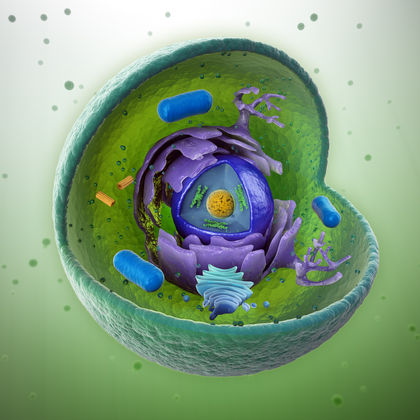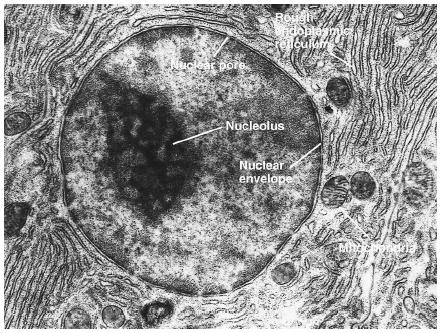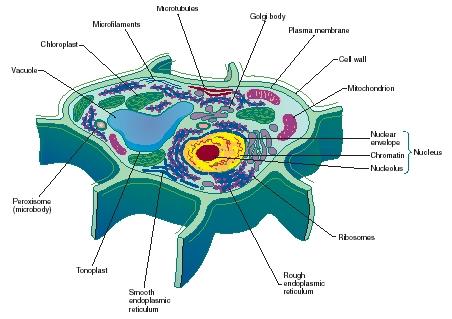Cell

The cell is the basic unit of a living organism. In multicellular organisms (organisms with more than one cell), a collection of cells that work together to perform similar functions is called a tissue. In the next higher level of organization, various tissues that perform coordinated functions form organs. Finally, organs that work together to perform general processes form body systems.
Types of cells
Multicellular organisms contain a vast array of highly specialized cells. Plants contain root cells, leaf cells, and stem cells. Humans have skin cells, nerve cells, and sex cells. Each kind of cell is structured to perform a highly specialized function. Often, examining a cell's structure reveals much about its function in the organism. For instance, certain cells in the small intestine have developed microvilli (hairs) that promote the absorption of foods. Nerve cells, or neurons, are another kind of specialized cell whose form reflects function. Nerve cells consist of a cell body and long attachments, called axons, that conduct nerve impulses. Dendrites are shorter attachments that receive nerve impulses.
Sensory cells are cells that detect information from the outside environment and transmit that information to the brain. Sensory cells often have unusual shapes and structures that contribute to their function. The rod cells in the retina of the eye, for instance, look like no other cell in the human body. Shaped like a rod, these cells have a light-sensitive region that contains numerous disks. Within each disk is embedded a special light-sensitive pigment that captures light. When the pigment receives light from the outside environment, nerve cells in the eye are triggered to send a nerve impulse in the brain. In this way, humans are able to detect light.
Cells, however, can also exist as single-celled organisms. The organisms called protists, for instance, are single-celled organisms. Examples of protists include the microscopic organism called Paramecium and the single-celled alga called Chlamydomonas .
Prokaryotes and eukaryotes. Two types of cells are recognized in living things: prokaryotes and eukaryotes. The word prokaryote literally means "before the nucleus." As the name suggests, prokaryotes are cells that have no distinct nucleus. Most prokaryotic organisms are single-celled, such as bacteria and algae.
The term eukaryote means "true nucleus." Eukaryotes have a distinct nucleus and distinct organelles. An organelle is a small structure that performs a specific set of functions within the eukaryotic cell. These organelles are held together by membranes. In addition to their lack of a nucleus, prokaryotes also lack these distinct organelles.
The structure and function of cells
The basic structure of all cells, whether prokaryote and eukaryote, is the same. All cells have an outer covering called a plasma membrane. The plasma membrane holds the cell together and permits the passage of substances into and out of the cell. With a few minor exceptions, plasma membranes are the same in prokaryotes and eukaryotes.
The interior of both kinds of cells is called the cytoplasm. Within the cytoplasm of eukaryotes are embedded the cellular organelles. As noted above, the cytoplasm of prokaryotes contains no organelles. Finally, both types of cells contain small structures called ribosomes. Ribosomes are the sites within cells where proteins are produced. (Proteins are large molecules that are essential to the structure and functioning of all living cells.) Ribosomes are not bounded by membranes and are not considered, therefore, to be organelles.
Words to Know
Cell wall: A tough outer covering that overlies the plasma membrane of bacteria and plant cells.
Cilia: Short projections that cover the surface of some cells and provide for movement.
Cytoplasm: The semifluid substance of a cell containing organelles and enclosed by the cell membrane.
Cytoskeleton: The network of filaments that provide structure and movement of a cell.
DNA (deoxyribonucleic acid): The genetic material in the nucleus of cells that contains information for an organism's development.
Endoplasmic reticulum: The network of membranes that extends throughout the cell and is involved in protein synthesis and lipid metabolism.
Enzyme: Any of numerous complex proteins that are produced by living cells and spark specific biochemical reactions.
Eukaryote: A cell that contains a distinct nucleus and organelles.
Flagellum: A whiplike structure that provides for movement in some cells.
Golgi body: Organelle that sorts, modifies, and packages molecules.
Membrane: A thin, flexible layer of plant or animal tissue that covers, lines, separates or holds together, or connects parts of an organism.
Mitochondrion: The power-house of the cell that contains the enzymes necessary for turning food into energy.
Nuclear envelope: The double membrane that surrounds the nucleus.
Nuclear pore: Tiny openings that stud the nuclear envelope.
Nucleolus: The darker region within the nucleolus where ribosomal subunits are manufactured.
Nucleus: The control center of a cell that contains the DNA.
Organelle: A membrane-bounded cellular "organ" that performs a specific set of functions within a eukaryotic cell.
Pili: Short projections that assist bacteria in attaching to tissues.
Plasma membrane: The membrane of a cell.
Plastid: A vesicle-like organelle found in plant cells.
Prokaryote: A cell without a true nucleus.
Protein: Large molecules that are essential to the structure and functioning of all living cells.
Protist: A single-celled eukaryotic organism.
Ribosome: A protein composed of two subunits that functions in protein synthesis.
Vacuole: A space-filling organelle of plant cells.
Vesicle: A membrane-bound sphere that contains a variety of substances in cells.
The structure of prokaryotes. An example of a typical prokaryote is the bacterial cell. Bacterial cells can be shaped like rods, spheres, or corkscrews. Like all cells, prokaryotes are bounded by a plasma membrane. Surrounding this plasma membrane is a cell wall. In addition, in some bacteria, a jelly-like material known as a capsule coats the cell wall. Many disease-causing bacteria have capsules. The capsule provides an extra layer of protection for the bacteria. Pathogenic bacteria with capsules tend to cause much more severe disease than those without capsules.
Within the cytoplasm of prokaryotes is a nucleoid, a region where the cell's genetic material is stored. (Genes determine the characteristics passed on from one generation to the next.) The nucleoid is not a true nucleus because it is not surrounded by a membrane. Also within the cytoplasm are numerous ribosomes.
Attached to the cell wall of some bacteria are flagella, whiplike structures that make it possible for the bacteria to move. Some bacteria also have pili, short, fingerlike projections that help the bacteria to attach to tissues. Bacteria cannot cause disease if they cannot attach to tissues. Bacteria that cause pneumonia, for instance, attach to the tissues of the lung. Bacterial pili greatly facilitate this attachment to tissues. Thus, bacteria with pili, like those with capsules, are often more deadly than those without.
The structure of eukaryotes. The organelles found in eukaryotes include the membrane system, consisting of the plasma membrane, endoplasmic reticulum, Golgi body, and vesicles; the nucleus; cytoskeleton; and mitochondria. In addition, plant cells have special organelles not found in animals cells. These organelles are the chloroplasts, cell wall, and vacuoles. (See the drawing of a plant cell on page 435.)
Plasma membrane. The plasma membrane of the cell is often described as selectively permeable. That term means that some substances are able to pass through the membrane but others are not. For example, the products formed by the breakdown of foods are allowed to pass into a cell, and the waste products formed within the cell are allowed to pass out of the cell. Since the 1960s, scientists have learned a great deal about the way the plasma membrane works. It appears that some materials are able to pass

through tiny holes in the membrane of their own accord. Others are helped to pass through the membrane by molecules located on the surface of and within the membrane itself. The study of the structure and function of the plasma membrane is one of the most fascinating in all of cell biology.
Endoplasmic reticulum. The endoplasmic reticulum (ER) consists of flattened sheets, sacs, and tubes of membrane that cover the entire expanse of a eukaryotic cell's cytoplasm. The ER looks something like a very complex subway or highway system. That analogy is not a bad one, since a major function of ER is to transport materials throughout the cell.
Two kinds of ER can be identified in a cell. One type is called rough ER and the other is called smooth ER. The difference between the two is that rough ER contains ribosomes on its outside surface, giving it a rough or grainy appearance. Rough ER is involved in the process of protein synthesis (production) and transport. Proteins made on the ribosomes attached to rough ER are modified, "packaged," and then shipped to various parts of the cell for use. Some are sent to the plasma membrane, where they are moved out of the cell and into other parts of the organism's body for use.
Smooth ER has many different functions, including the manufacture of lipids (fatlike materials), the transport of proteins, and the transmission of nerve messages.
The Golgi body. The Golgi body is named for its discoverer, the nineteenth century Italian scientist Camillo Golgi (1843–1926). It is one of the most unusually shaped organelles. Looking somewhat like a stack of pancakes, the Golgi body consists of a pile of membrane-bounded, flattened sacs. Surrounding the Golgi body are numerous small membrane-bounded vesicles (particles). The function of the Golgi body and its vesicles is to sort, modify, and package large molecules that are secreted by the cell or used within the cell for various functions.
The Golgi body can be compared to the shipping and receiving department of a large company. Each Golgi body within a cell has a cis face, which is similar to the receiving division of the department. Here, the Golgi body receives molecules manufactured in the endoplasmic reticulum. The trans face of the Golgi body can be compared to the shipping division of the department. It is the site from which modified and packaged molecules are transported to their destinations.
Vesicles. Vesicles are small, spherical particles that contain various kinds of molecules. Some vesicles, as noted above, are used to transport molecules from the endoplasmic reticulum to the Golgi body and from the Golgi body to various destinations. Special kinds of vesicles perform other functions as well. Lysosomes are vesicles that contain enzymes involved in cellular digestion. Some protists, for instance, engulf other cells for food. In a process called phagocytosis (pronounced FA-go-sy-to-sis), the protist surrounds a food particle and engulfs it within a vesicle. This food-containing vesicle is transported within the protist's cytoplasm until it is brought into contact with a lysosome. The food vesicle and lysosome merge, and the enzymes within the lysosome are released into the food vesicle. The enzymes break down the food into smaller parts for use by the protist.
The nucleus. The nucleus is the control center of the cell. Under a microscope, the nucleus looks like a dark blob, with a darker region, called the nucleolus, centered within it. The nucleolus is the site where parts of ribosomes are manufactured. Surrounding the nucleus is a double membrane called the nuclear envelope. The nuclear envelope is covered with tiny openings called nuclear pores.
The nucleus directs all cellular activities by controlling the synthesis of proteins. Proteins are critical chemical compounds that control almost everything that cells do. In addition, they make up the material from which cells and cell parts themselves are made.
The instructions for making proteins are stored inside the nucleus in a helical molecule called deoxyribonucleic acid, or DNA. DNA molecules differ from each other on the basis of certain chemical units, called nitrogen bases, that they contain. The way nitrogen bases are arranged within any given DNA molecule carries a specific genetic "message." One arrangement of nitrogen bases might carry the instruction "Make protein A," another arrangement of bases might carry the message "Make protein B," yet a third arrangement might code for the message "Make protein C," and so on.
The first step in protein synthesis begins in the nucleus. Within the nucleus, DNA is translated into a molecule called messenger ribonucleic acid (mRNA). MRNA then leaves the nucleus through the nuclear pores. Once in the cytoplasm, mRNA attaches to ribosomes and initiates protein synthesis. The proteins made on ribosomes may be used within the same cell or shipped out of the cell through the plasma membrane for use by other cells.
The cytoskeleton. The cytoskeleton is the skeletal framework of the cell. Instead of bone, however, the cell's skeleton consists of three kinds of protein filaments that form networks. These networks give the cell shape and provide for cellular movement. The three types of cytoskeletal fibers are microtubules, actin filaments, and intermediate filaments.
Microtubules are very thin, long tubes that form a network of "tracks" over which various organelles move within the cell. Microtubules also form small, paired structures called centrioles within animal cells. These structures are not considered organelles because they are not bounded by membranes. Centrioles are involved in the process of cell division (reproduction).
Some eukaryotic cells move about by means of microtubules attached to the exterior of the plasma membrane. These microtubules are called flagella and cilia. Cells with cilia also perform important functions in the human body. The airways of humans and other animals are lined with such cells that sweep debris and bacteria upwards, out of the lungs and into the throat. There, the debris is either coughed from the throat or swallowed into the digestive tract, where digestive enzymes destroy harmful bacteria.
Actin filaments are especially prominent in muscle cells, where they provide for the contraction of muscle tissue. Intermediate filaments are relatively strong and are often used to anchor organelles in place within the cytoplasm.

Mitochondria. The mitochondria are the power plants of cells. Each sausage-shaped mitochondrion is covered by an outer membrane. The inner membrane of a mitochondrion is folded into compartments called cristae (meaning "box"). The matrix, or inner space created by the cristae, contains the enzymes necessary for the many chemical reactions that eventually transform food molecules into energy.
Plant organelles. Plant cells have several organelles not found in animal cells. These include plastids, vacuoles, and a cell wall.
Plastids are vesicle-type organelles that perform a variety of functions in plants. For example, amyloplasts store starch and chromoplasts store pigment molecules that give some plants their vibrant orange and yellow colors. Chloroplasts are plastids that carry out photosynthesis, a process in which water and carbon dioxide are transformed into sugars.
Vacuoles are large vesicles bound by a single membrane. In many plant cells, they occupy about 90 percent of the cellular space. They perform a variety of functions in the cell, including storage of organic compounds, waste products, pigments, and poisonous compounds as well as digestive functions.
All plant cells have a cell wall that surrounds the plasma membrane. The cell wall of plants consists of a tough carbohydrate substance called cellulose laid down in a medium or network of other carbohydrates. (A carbohydrate is a compound consisting of carbon, hydrogen, and oxygen found in plants and used as a food by humans and other animals.) The cell wall provides an additional layer of protection between the contents of the cell and the outside environment. The crunchiness of an apple, for instance, is attributed to the presence of these cell walls.
[ See also Chromosome ; Enzyme ; Neuron ; Nucleic acid ; Protein ; Reproduction ; Respiration ]
Lea Vorpahl
i truly understand the functions of each organelle.
AND it can help me on my studying
WHAT ARE THE DIFFERENCES OF HUMAN CELL,ANIMAL CELL AND PLANT CELL?
this site is really great,it helps the students to find the answer in there science question about the cell...this is very cool...
But still I have a question to ask more about ribosome
Thanks.
WE LOVE THIS WEB SITE
Great JOB!!!
U
thanks for information about cells
Give 4 examples of types of animal cells in human
Thanks
what are characteristics of science